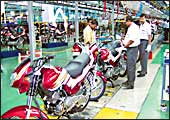 |
| POWER DRIVE: TVS' mobike plant at Hosur
has placed the company among front-runners in the auto comp
race |
In
the late nineties, when the split between Suzuki and TVS Motor Company
was beginning to appear inevitable, the Indian company's R&D
team was just about ready with its four-stroke scooter, Spectra.
The product didn't exactly set the Cauvery on fire, but that's not
important. What is relevant is that the Spectra gave TVS the confidence
it needed to develop a four-stroke engine without Suzuki. In 2000,
the blueprint for the Victor was formulated, and TVS gave itself
18 months to come up with an indigenous four-stroke bike. ''It was
intensive work,'' recalls Vinay Harne, Vice President, R&D.
The development of the Spectra might have provided motivation, but
little else. For starters, TVS had to develop a 100cc engine; the
Spectra is 150cc, bring in fuel efficiency (not the Spectra's strongest
point), styling, and other features like smooth acceleration and
deceleration. Intensive work, indeed.
Before the Victor eventually hit the market
in September 2001, four prototypes did the rounds for customer feedback,
based on which improvements were made. During trials, the company
went to the extent of fitting sensors to the head, elbows and other
joints of the rider to judge trauma impact when the bike went over
potholes and speed-breakers and to reduce the impact to a minimum.
The trials also ensured that deficiencies in existing bikes were
removed-for instance, avoiding poor torque and pick-up response
and ensuring optimum power and acceleration. Venu Srinivasan, Chairman
& Managing Director, TVS Motor Co, was confident enough at launch
time to assert that ''the Victor is a star for TVS''. And all at
an investment of Rs 80 crore.
He's dead right. Today, there are some 1 million
Victors on the roads. Marketshare has climbed from 6 to 10 to 12
per cent, and is expected to stabilise at 10 per cent as newer products
arrive in the TVS stable. The Victor GLX, an upgraded version of
the Victor, which was launched in July, sold 10,000 bikes in the
first month. An economy variant is expected in September to take
on Bajaj's Boxer.
|
|
|
RUNNING ON R&D
|
»
Made Victor a sensation with just Rs 80 crore of
investment
» 1
million Victors on the roads today
» Some
30 machines have been designed in-house
» Economy
variant of Victor scheduled for launch soon
» VT-i
technology a key differentiator |
Consumers might have got a glimpse of TVS' design
and development capabilities by 2001 with the Victor launch, but
few would be aware that the seeds of those competencies were sowed
way back in 1992-93, when the company initiated a change management
process. Total Quality Management was kicked off, and measures like
cost controls and manpower reduction-which may appear run-of-the-mill
today, but were pretty radical (not just by southern standards)
a decade ago-were implemented. Shopfloor operators, for so long
quantity-obsessed, were tuned to become quality-oriented. Manufacturing
cells were formed, accountability fixed. Supplier rationalisation
also began.
If in the 1990-95 period, the focus was on employer
involvement, education and training and the restructuring of manufacturing
with TQM for the top management, the spotlight by the second half
of the nineties moved on to sales, service and improvements-and,
most important, new product development. Computer-aided designs
were in, robotics was being used in manufacturing, and computer-controlled
systems monitored supplier deliveries on a monthly and weekly basis
on the shop floor.
TVS opted for its own customised machine tooling
to the maximum extent. Some 30 machines were designed in-house with
newer concepts. ''Buying machines is like a buying a pc readymade-they
could have a number of features that we won't use, and may not have
the one we most require,'' explains K.N. Radhakrishnan, Vice President,
Planning.
It was decided that the manufacturing line
would be lean and flexible, with an ability to make several models
at once. This came at a cost, but the management was clearly investing
in the future. Today the Victor and its new upgrade are made on
one line, and the Centra and Scooty Pep on another. ''Flexibility
is important because products have a lower shelf life; variety is
becoming the order of the day,'' says Srinivasan. Since the launch
of the Victor 23 products have entered the market.
One of the strategies the TVS team has been
implementing ever since the development of the Victor is the creation
of patents. The Victor's key differentiator, for instance, is the
ignition's digital mapping, which reveals to users whether the engine
is in power mode or in economy mode. That's not the only patent
in the TVS vault. A team of 400 engineers is responsible for the
55-odd patents till date, 20 per cent of them for process development,
and the rest for product development. The VT-i technology in the
Centra and the Victor GLX is one manifestation of the R&D team's
handiwork.
The VT-i uses effective combustion. There is
a twin spark, with the second one following immediately after the
first, after adjusting to engine temperature and completing the
combustion process; this gets effectively translated to the wheel
by eliminating friction. During deceleration, under normal circumstances
the engine sucks fuel, but VT-i technology stops fuel flow to the
engine without stalling it.
Immediately after the split with Suzuki, Srinivasan
had declared: ''We can no longer stop with one product launch for
three years, now it has to be three products in one year.'' He obviously
knew what he was talking about. Expect more products, and more technological
innovations like the VT-i in those TVS machines.
|
